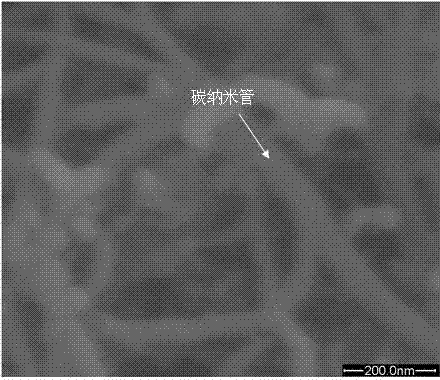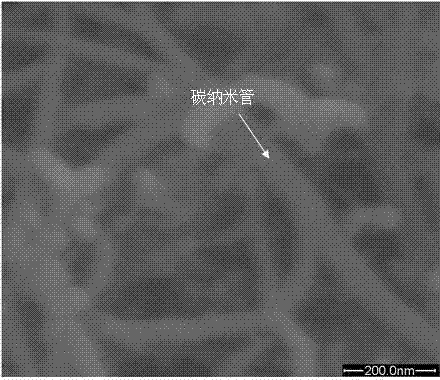Preparation method for functional fiberglass-reinforced epoxy resin composite material
A glass fiber and epoxy resin technology, applied in the nano field, can solve the problems of weak interface bonding and difficult wetting of composite materials, and achieve the effect of improving interface bonding strength and bonding performance.
- Summary
- Abstract
- Description
- Claims
- Application Information
AI Technical Summary
Problems solved by technology
Method used
Image
Examples
Embodiment l
[0024] Example 1: Multi-walled carbon nanotubes (OD<8nm) prepared by arc discharge method and glass fibers are used as initial raw materials. After purification, acidification and acylation of multi-walled carbon nanotubes, acylated carbon nanotubes are obtained, and then reacting the acylated carbon nanotubes with a γ-aminopropyltriethoxysilane coupling agent solution to obtain a carbon nanotube surface grafted with a coupling agent, and then combining the carbon nanotubes grafted with a coupling agent on the surface with The glass fiber is reacted to obtain a functionalized glass fiber reinforced body; the obtained functionalized glass fiber reinforced body is compounded with an epoxy resin matrix to obtain a glass fiber reinforced epoxy resin composite material.
[0025] Step (1): In a 250mL single-necked round bottom flask equipped with a stirrer, add 1.1g of dried multi-walled carbon nanotube raw material and 100mL, 20% nitric acid solution, treat it under 1kHz ultrasonic ...
Embodiment 2
[0032] Example 2: Single-walled carbon nanotubes (OD<1nm) and glass fibers prepared by laser evaporation were used as initial raw materials. After purification, acidification and acylation of single-walled carbon nanotubes, acylated carbon nanotubes were obtained, and then The acylated carbon nanotubes are reacted with N-β (aminoethyl)-γ-aminopropyltrimethoxysilane coupling agent solution to obtain carbon nanotubes surface grafted with coupling agent, and then the surface grafted with The carbon nanotube of the coupling agent reacts with the glass fiber to obtain a functionalized glass fiber reinforced body; the obtained functionalized glass fiber reinforced body is compounded with an epoxy resin matrix to obtain a glass fiber reinforced epoxy resin composite material.
[0033] Step (1): In a 250mL single-neck round bottom flask equipped with a stirrer, add 2.1g of dried multi-walled carbon nanotube raw material and 100mL, 20% nitric acid solution, treat it under 50kHz ultrason...
Embodiment 3
[0040] Example 3: Single-walled carbon nanotubes (OD<10nm) prepared by laser evaporation method and glass fibers are used as initial raw materials. After purification, acidification and acylation of single-walled carbon nanotubes, acylated carbon nanotubes are obtained, and then The acylated carbon nanotubes are reacted with γ-aminoethylaminopropyltrimethoxysilane coupling agent solution to obtain carbon nanotubes with coupling agent grafted on the surface, and then carbon nanotubes with coupling agent grafted on the surface The tube reacts with the glass fiber to obtain a functionalized glass fiber reinforced body; the obtained functionalized glass fiber reinforced body is compounded with an epoxy resin matrix to obtain a glass fiber reinforced epoxy resin composite material.
[0041] Step (1): In a 250mL single-neck round bottom flask equipped with a stirrer, add 1.1g of dried multi-walled carbon nanotube raw material and 100mL, 30% sulfuric acid solution, treat it under 40kH...
PUM
 Login to View More
Login to View More Abstract
Description
Claims
Application Information
 Login to View More
Login to View More - R&D
- Intellectual Property
- Life Sciences
- Materials
- Tech Scout
- Unparalleled Data Quality
- Higher Quality Content
- 60% Fewer Hallucinations
Browse by: Latest US Patents, China's latest patents, Technical Efficacy Thesaurus, Application Domain, Technology Topic, Popular Technical Reports.
© 2025 PatSnap. All rights reserved.Legal|Privacy policy|Modern Slavery Act Transparency Statement|Sitemap|About US| Contact US: help@patsnap.com


